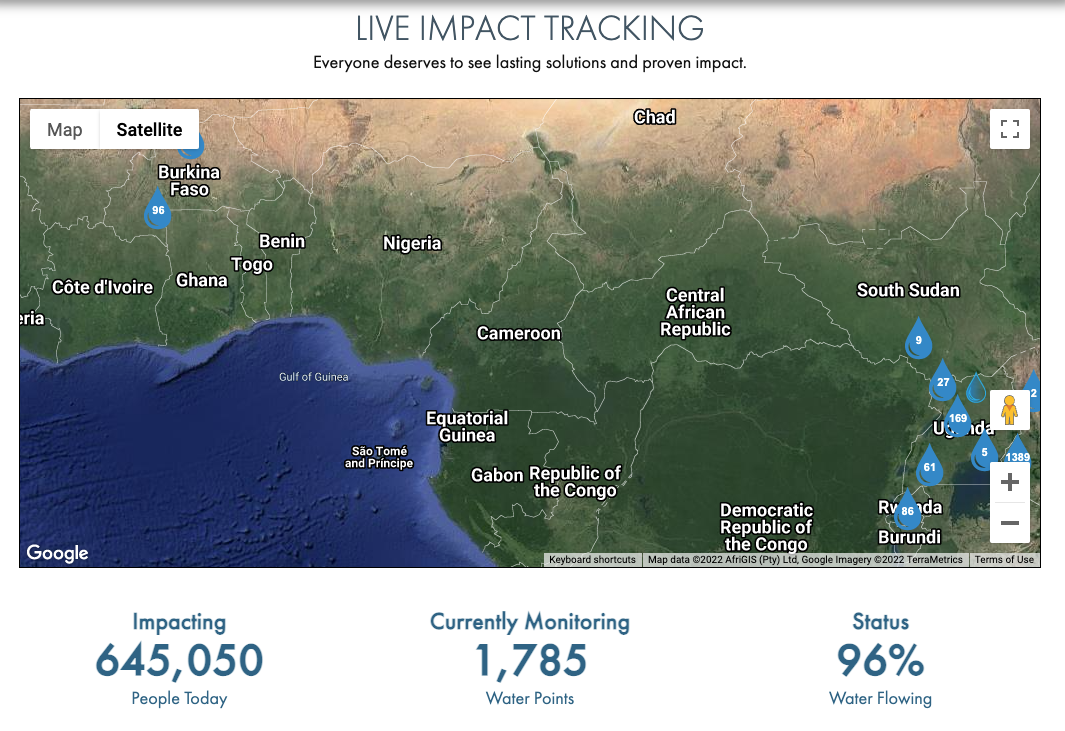What we learn together
Why Transparency is the Future in a Data-Driven World

A screenshot of TWP’s live impact-tracking map, where the latest data on every TWP water point is publicly available.
Shortly after I started my job at The Water Project, I met with The Water Project’s founder Peter Chasse, who sat all the new employees down to explain The Water Project’s story, mission, and values.
“If you want to tackle any other global problem, it begins with access to water,” Peter said. “There’s something about water. It’s so fundamental to life.”
As a newbie, I appreciated the explanation. In the months that have followed, though, I have come to appreciate that meeting for what it was: just one link in a chain of transparency that The Water Project forges every day.
Ask anyone working here for a while, and they’ll tell you Peter has a knack for predicting the future. He knew cryptocurrency would be big before it was making headlines worldwide. Workplace legend (i.e., Dan from Operations) says Peter foretold the sprawling impact of COVID-19 in the early days of 2020. Before I even knew what an NFT was (confession: I still don’t, really—don’t tell Peter), he was talking about their impending popularity at an employee get-together.
And, for a long time, The Water Project has valued transparency: sharing what goes on behind the scenes with employees and donors. Being transparent shows not only that we are doing great things, but also that we make mistakes (from which we can learn).
Transparency can be scary for nonprofits. Making an organization’s inner workings public exposes them to scrutiny. Cancel culture permeates social media, decimating reputations and futures. People, businesses, and organizations end up shunned because of a trending topic on social media, whether or not those jumping on hashtag bandwagons have taken the time to research the issue(s) at hand. With so much data available to everyone all the time, being transparent as a nonprofit is both brave and challenging.
But with this tense social climate, demand for transparency is only growing, especially when people surrender their hard-earned money to aid a cause they believe in. There are always stories to get donors concerned: that their money won’t do what organizations say it will, or that their donation will be mismanaged. As far back in history as people have given their surpluses to the needy, there have always been shady types to take advantage of that fact. But, there are easy ways for donors to feel confident about placing their money in a nonprofit’s hands.
Financial transparency, at least, is required by law for nonprofit organizations in many countries and states. But one widely cited study demonstrated that, in this era where anyone can be a detective, donors give more (53% more!) to organizations that are transparent—in more than just their annual financials. Another study concluded that transparency is one of the essential aspects many donors research about charities. The Federal Trade Commission advises donors to watch out for “sentimental claims with few details” and make sure they know precisely how their donations will be used.
Peter finished that new employee meeting by tying in three components The Water Project strives for: reliability, relationship, and trust. Without honesty, none of these are possible. Transparency should be near the top of every nonprofit organization’s priority list.
The Water Project is constantly working to publicize data about the status of our work in real-time to both donors and casual site-browsers. We monitor the issues facing our constituents and take steps to mitigate crises as they emerge. Trust is vital to us.
With transparency in mind, below are a few handy resources to vet the nonprofit (s) you’re interested in—whether it’s The Water Project or another deserving charity.
Sites like Charity Navigator, Great Nonprofits, CharityWatch, Guidestar/Candid, BBB Wise Giving Alliance, and more. These organizations’ entire purpose is to assist people in understanding whether nonprofits will use their donations well. It’s helpful to check a few different sites rather than relying on just one. It’s also advantageous to read donors’ reviews directly, like on Great Nonprofits—there, you’re getting to hear exactly what donating to an organization is like before you do it!
If you’re donating from within the United States, government sites provide excellent information. The Federal Trade Commission offers easy tips on how to tell whether an organization or a request for a donation is legitimate. The Internal Revenue Service will provide any tax returns that nonprofits make public. Nonprofits must make known tax returns from the previous three years if they are a tax-exempt organization (which means any donations made to that organization will be tax-deductible!).
Another sometimes-overlooked resource for vetting an organization is social media. The nonprofit’s profiles will tell you what the average person thinks about the nonprofit you’re investigating. Are there angry comments on their posts? Unanswered questions? These can be (but aren’t always) signs of charities with things to hide.
Home More Like ThisTweet